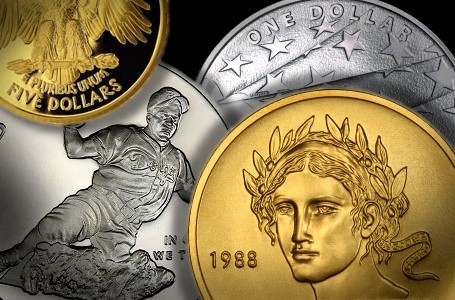by Louis Golino for CoinWeek ……
On September 21 legislation was introduced by Republican members of congress that could have a major impact on U.S. commemorative coin programs. If passed and ultimately enacted into law, such legislation would require that any funds raised by such coins beyond the cost to recoup production expenses would go toward deficit reduction rather than allow a portion to go towards private nonprofit groups that currently receive a surcharge from the sale of such coins.
But coin experts counter that under existing arrangements, only a small amount of the money raised by these coins benefits the private entities that promote the issuance of the coins, and that the funds are ultimately used to support programs and missions that affect a large number of Americans in most cases.
 The Commemorative Coins Reform Act, which was introduced by Senator Jim DeMint (Republican of South Carolina) and Representative Justin Amash (Republican of Michigan), would end the practice that has been used since 1982 in which a surcharge is added to the price of commemorative coins authorized by Congress. The Senate Bill is S. 3612, and the House Bill is H.R. 6495.
The Commemorative Coins Reform Act, which was introduced by Senator Jim DeMint (Republican of South Carolina) and Representative Justin Amash (Republican of Michigan), would end the practice that has been used since 1982 in which a surcharge is added to the price of commemorative coins authorized by Congress. The Senate Bill is S. 3612, and the House Bill is H.R. 6495.
According to the U.S. Mint’s web site (www.usmint.gov), in the years since 1982 over $418 million has been generated for the organizations that promote the people, places, and institutions commemorated on U.S. commemorative coins. While that sounds like a lot, the money is divided among many dozens of coins over a 30 year period.
Currently, each silver dollar includes a $10, or roughly 20% surcharge, while $5 gold coins include a $35, or approximately 7% surcharge. Clad half dollars, which are not issued as often as the silver and gold coins, come with a $5 surcharge.
The organizations include groups like the Maryland War of 1812 Bicentennial Commission, which received money from the sale this year of the Star-Spangled Banner silver and gold commemorative coins, or the Girl Scouts of the USA, which will receive funding from the sale next year of the Girl Scouts of the USA Centennial silver dollar.
Groups like those often have access to professional lobbying firms that work to promote the authorization of coins by the Congress. The Wall Street Journal reported in June that Sen. Mark Kirk (Republican of Illinois) was responsible for the passage of “commemorative coin bills that benefited a lobbying firm connected to his former girlfriend,” according to a September 24 report in the Hill newspaper which covers developments on Capitol Hill and in the U.S. Congress.
That incident is widely viewed as a large part of the impetus for the new legislation, but it is not representative of the commemorative coin process as a whole in the view of coin experts.
In the view of individuals such as the members of congress who introduced these bills, these programs amount to a backdoor method to circumvent the congressional ban on earmarks, which are provisions added to bills by members of congress that seek to provide funding for projects in that member’s congressional district. They are often compared to congressional pork funding.
Senator DeMint noted that “Congress has done great work on eliminating earmarks, but commemorative coins have become a way for politicians to continue steering federal benefits to favored projects. Congress can still issue commemorative coins, but the funds should go to deficit reduction instead of becoming a money maker for private entities. If organizations wish to raise money for worthy causes, there are many ways available without the use of taxpayer resources.”
Rep. Amash added that “Organizations shouldn’t receive special treatment because of their DC connections. It’s far beyond the proper role of the federal government to act as the sales agent for private groups.”
Currently the Senate version of the legislation has seven co-sponsors, while the House bill has one.
Michael Zielinski of CoinUpdate wrote on September 27 in his Mint News Blog (www.mintnewsblog.com) that this legislation would reduce the incentive for private organizations to pursue topics for commemorative coins that “might not be the most nationally significant for a particular year” and that if passed it may result in “a more even handed selection and a broader range of topics for future commemorative coin programs.”
Recent legislation making its way through Congress calls for the issuance of coins to honor the Pro Football Hall of Fame and the Lions Club International, which could arguably be considered to be lack broad national appeal and resonance. However, such topics, and the developments surrounding Senator Kirk’s involvement in the process, are probably the exception more than the rule.
For example, next year’s two coin programs will honor the Girl Scouts of the USA, an organization with close to 4 million members and almost 60 million alumni, and Army 5 Star Generals like General Dwight D. Eisenhower. The programs slated for 2014 will commemorate the semicentennial of the 1964 Civil Rights Act and the National Baseball Hall of Fame. Baseball is often described as America’s pastime.
The conservative Heritage Foundation (www.heritage.org) has argued in several recent reports that the surcharge on commemorative coins amounts to a congressional earmark for private groups.
But according to a counterpoint article in Mr. Zielinksi’s CoinUpdate web site from April by Les Peters, that was written in reaction to the Heritage reports, these coin programs are actually very different from earmarks.
Mr. Peters explains that cost to make and promote these coins comes from the U.S. Mint’s Pubic Enterprise Fund, which is mainly funded by seigniorage, or the difference between the cost to produce circulation coins and their face value. In the past when the U.S. still made dollar coins for circulation, which ended in late 2012, seigniorage was responsible for generating hundreds of millions of dollars, a portion of which went towards deficit reduction.
Mr. Peters explained that seigniorage expenses are later recouped through sales of commemorative coins and that that process is very different from earmarks, which are funded directly through the federal budget. In addition, surcharges are only sent to groups if enough coins are first sold to cover all costs associated with the production, design, and promotion of the coins. Moreover, he explains, the organization also has to prove that it is able to “independently raise an equal amount of donations from public sources as they are intended to receive from the coin program,” which is not applicable to earmarks.
Finally, Mr. Peters explains that unlike earmarks, which are decided by members of congress, commemorative coin sales are the result of decisions by the U.S. public to purchase those coins, which is a “better measure of support for an organization than is the existence of a group of paragraphs in legislation that can be measured in the hundreds of pages.”
Members of Congress who support the current system, such as Rep. Mike Honda (Democrat of CA) also explain that coin bills are vetted by congressional committees, and that members who oppose a coin bill and the method it uses to support a group or cause, can simply vote against the bill. Mr. Honda has sponsored legislation to create coins that would commemorate the opening of the Panama Canal and the Panama-Pacific International Exposition in San Francisco.
But other experts such as Eric Jordan, author of several books on modern commemorative coins, maintain that “Anything you can do to get self interest for special interest groups out of the equation, the better off we are.”
He also told CoinWeek that the quality of the designs and themes on our commemorative issues would benefit from the proposed change.
Other numismatic experts point out that private nonprofit groups will still be able to lobby Congress for coins they believe should be issued, and that the design process and theme selection are not a function of special interest influence, but are the result of a much broader process involving many other actors, including the U.S. Mint, members of congress, the Commission on Fine Arts, the Citizen Coinage Advisory Commission, and the public, which has avenues for impacting the process, including contacting their member of congress.
 Louis Golino is a coin collector and numismatic writer, whose articles on coins have appeared in Coin World, Numismatic News, and a number of different coin web sites. His column for CoinWeek, “The Coin Analyst,” covers U.S. and world coins and precious metals. He collects U.S. and European coins and is a member of the ANA, PCGS, NGC, and CAC. He has also worked for the U.S. Library of Congress and has been a syndicated columnist and news analyst on international affairs for a wide variety of newspapers and web sites.
Louis Golino is a coin collector and numismatic writer, whose articles on coins have appeared in Coin World, Numismatic News, and a number of different coin web sites. His column for CoinWeek, “The Coin Analyst,” covers U.S. and world coins and precious metals. He collects U.S. and European coins and is a member of the ANA, PCGS, NGC, and CAC. He has also worked for the U.S. Library of Congress and has been a syndicated columnist and news analyst on international affairs for a wide variety of newspapers and web sites.





Great reporting Louis.
I know Mr. Amash was one of the nay votes on the 2014 National Baseball Hall of Fame Commemorative program, along with Ron Paul and Paul Broun (R-GA). I agreed with his statements then, but not on this.
Thanks very much, Charles and Hubert, for your kind words and the info. on Rep. Amash. I tried to present a balanced view of the issue.
One small correction: According to a report in today’s edition of Coin World (published online Oct. 1) commemoratives issued since 1983, not 1982 as I wrote, have included the surcharges. The 1982 George Washington half dollar is therefore the one modern commemoratve that has not included the surcharge provision.
Yes, that coin’s proceeds went to pay off the national debt.
Something about the ideas at work in this bill and bills like it compels me to be more specific…
I’m against this bill b/c we already have vetting processes at work that should (theoretically) weed out the corrupt bills. If these processes aren’t working, it’s probably the fault of the legislators involved. If the legislators involved are corrupt, then we have a vetting process for them too – it’s called voting.
Ironically (and I say that with a big ol’ toothy grin), this bill is just more unnecessary gov’t.
I agree with Hubert, and would add that under the current system, or the one that would exist if this became law, it is members of congress, not special interests, that would continue to drive the process. It’s their role that is decisive. The fact that we have so many recent military issues when there are so many other worthy themes we could have commemorated ultimately reflects the collective will of the Congress, not the gorups that wanted the coins made. I think there is a lot of pressure on members to approve things like all those military coins for fear of appearing weak on defense issues. Too bad the rocket scientists at NASA don’t have a lobbyist. Coin collectors would love a NASA coin.
Really excellent reporting here, Louis. You have given a good and balanced look at the arguments by both sides.
On the arguments relating to corruption, I think that in the long run it doesn’t matter a whole lot as nearly any political process is open to corruption when run by government officials, elected or otherwise. I can certainly understand why DeMint and Amash are doing what they’re doing, but I’m not sure it’ll have an appreciable effect.
With that having been said, I think I lean somewhat more towards Michael’s point of view that we might get better coin topics if we passed the DeMint bill. We’ve had some good coins produced by the current process, such as this year’s Star Spangled Banner silver coins, but we’ve also had some less than impressive ones as well. The Capitol Visitor’s Center comes to mind.
Thanks, Capt., for you insightful comments and very kind words. If nothing else, the proposed legislation has got people thinking about the best way to set up the commemorative program.